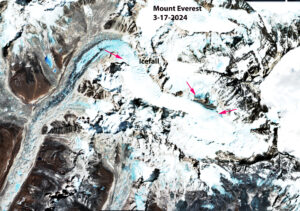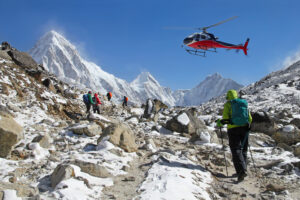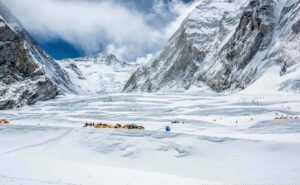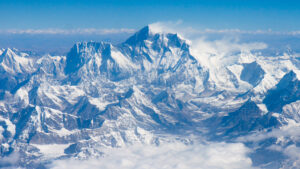As the last days of a busy 2023 tick down, it is time to reflect on the evolution of high-altitude mountaineering and our values and priorities in the face of growing commercialization.
While adventure is alive and well, there is also concern. The real success of an expedition is not the summit but the safe return home. There have been many summits this year, but also far too many avoidable deaths.
The winter 8,000’ers
It was an exciting winter on the 8,000’ers. David Goettler and Herbe Barmasse made an alpine-style attempt on Dhaulagiri, Alex Txikon and a Seven Summit Treks sherpa team tried Manaslu, and Gelje Sherpa, Adriana Brownlee, and record-chaser Kristin Harila attempted Cho Oyu from Nepal.
Only Txikon’s team succeeded. Barmasse and Goettler insisted on climbing in good style, and bad weather prevented that, so they went home. High winds likewise pushed back the team on Cho Oyu’s south face.
A powerful Russian group attempted the same Cho Oyu challenge in October, and while they made good progress, they ran out of time before they could open the route from the long SSW ridge to the summit.

Tenjen Lama Sherpa on the summit of Manaslu, Jan. 6, 2023. He climbed 14 8,000’ers in three months but died in an avalanche on Shishapangma in November. Photo: Alex Txikon
Another winter climb, far from the Himalaya, was Jost Kobusch’s solo ascent of Denali. The German climber became one of the few to complete the feat.
Meanwhile, Marcin Tomaszewski and Pavel Haldas opened the first big-wall route in Greenland during winter.
Harila’s record 2.0
Determined to break Nirmal Purja’s speed record for the 14×8,000’ers, but unable to snag permits for Cho Oyu and Shishapangma in Tibet in 2022, Kristin Harila made a radical decision. She would start her project again from scratch, in a million-dollar quest that used the considerable resources of Seven Summit Treks — and not insignificantly, their contacts with the Tibet Mountaineering Association. On April 26, Harila reset her counter in Tibet and summited Shishapangma.

Kristin Harila. Photo: Wikipedia
Some of the company’s strongest sherpas, including Tenjen Lama Sherpa, supported her. The team was willing to push in tough conditions, as demonstrated on Manaslu and K2.
Their quest had a remarkable impact on the record-seeking crowd. It demonstrated how logistics, determination, remarkable physical and mental strength, and plenty of resources (including helicopters, even in Pakistan) are all crucial to ticking off summits at that pace.
Harila’s record also spurred a bitter debate when a Pakistani porter died on K2 on the same day she finished her quest.
Other record seekers, perhaps motivated by Harila’s success, paid a high price for their dreams. On Shishapangma, a crazy race to become the first American woman to finish the 14×8,000’ers ended in tragedy. Guiding one of the competitors, Tenjen Lama did not live to see the end of the year.
A difficult Patagonia season
Sadly, climate change played a major role in mountaineering this year. In both Patagonia and on Aconcagua, there were accidents and long spells of bad weather.
Despite a fruitful season during which Matteo de la Bordella and Leo Gheza opened a new route on Mermoz with Sean Villanueva O’Driscoll, the talented pair couldn’t finish their ambitious Fitz Roy traverse.
Winter was strange in the Alps, with very dry conditions and then loads of spring snow. Local climbers did their best to adapt to the variable conditions.

Sean Villanueva O’Driscoll on Fitz Roy and Mermoz. Photo: Mateo Della Bordella
The Annapurna miracle
The spring Himalayan season started ominously with annoying new regulations. Trekkers were not allowed to go on their own through most of Nepal.
As usual, Everest was king, but perhaps the most amazing news of the year came from Annapurna, with the spectacular rescue of Anurag Maloo. When Maloo fell into a crevasse on the riskiest part of the route, family and friends energetically mobilized a rescue.
Three days had passed when Adam Bielecki and Mariusz Hatala, who were in the area to attempt the peak’s northwest face, volunteered for a complex rescue inside the crevasse. Supported by a sherpa team, Bielecki descended over 60m into the crevasse and found Maloo’s body. To Bielecki’s astonishment, Maloo showed signs of life.

Adam Bielecki’s selfie shows his face of astonishment at discovering that Anurag Maloo was alive after three days in a crevasse. Photo: Adam Bielecki
Maloo’s miracle run of luck continued when doctors in Pokhara kept him alive by practicing CPR for nearly four hours. He was then transferred to a bigger hospital in Kathmandu, then to another in Delhi, India. Finally, he was released from the hospital in November and is learning to walk again. He was even able to speak with us in a moving interview.
Annapurna saw at least six more rescues and the death of guide Noel Hanna. Several rescues were required when no-O2 climbers did not turn around before their situations became dire. This was the case for Baljeet Kaur on Annapurna and Piyali Basak on Makalu.
Some have argued that publications should stop covering these expeditions. We explained why we continue to report on 8,000m expeditions.
The saddest Everest record
Everest triggered the usual debate about the overuse of helicopters, inexperienced climbers, and crowds. A handful of clients claimed that they would try for the summit without O2, but most of them were heavily supported.
Yet some were willing to climb in elegant style. Russians Vitali Lazo and Anton Pugovkin tried to climb without O2 and then descend on skis. Suhajda Szilard of Hungary climbed alone, carrying his tent and gear. (He only used the fixed ropes.) Unfortunately, his climb ended tragically. Szilard died, possibly of exhaustion, just before the summit.
Szilard’s death was not the only tragedy. As summit waves continued in very good conditions, videos started appearing online showing climbers collapsed in the snow, some of them abandoned by their teams. There were reports of climbers missing, a strange situation among such crowds.
In the end, Everest broke the worst possible record. A record 18 people died, only three of them in mountain accidents.

Suhajda Szilard in Camp 2 on Everest. Photo: Suhajda Szilard
Meanwhile, a few alpine-style teams quietly made some of the most remarkable ascents of the year. Mathieu Mainadier, Roger Schaeli, and Simon Gietl completed a new route on Meru South. Czech Mare Holecek finished a “simply beautiful” line up Sura Peak with Matej Bernat, and veterans Peter Hamor, Nives Meroi, and Romano Benet climbed Kabru South, a virgin 7,000’er in the Kangchenjunga region.
Polish skiers
Also worth mentioning are the Polish high-altitude climbing and skiing expeditions. Bartek Ziemski, filmed by Oswald Rodrigo Pereira, completed flawless no-O2 ascents on Annapurna and Dhaulagiri, followed by complete ski descents.
Ziemski then helped rescue Carlos Soria, who was injured during his summit push. At 84 years old and on his 12th attempt at a peak that has eluded him for decades, Soria had to be carried down from above Camp 3 with a broken leg.
In Pakistan, Andrzej Bargiel skied down Gasherbrum I and II, and Anna Tybor skied from the summit of Broad Peak.

Bartek Ziemski, left, and Oswald Pereira during his ascent on Annapurna. Photo: Oswald Rodrigo Pereira
Pakistan
As usual for the last few years, the last climbs in Nepal merged with news of those heading to Pakistan.
Denis Urubko and Pipi Cardell attempted to open a new route in alpine style on Gasherbrum I. The couple spent almost the entire season there, fixing a good part of the normal route and summiting that way for acclimatization. Yet they were unable to complete their new route because of poor conditions.
Benjamine Vedrines and David Goettler attempted Nanga Parbat’s Rupal Face but didn’t summit. A Czech team returned to Muchu Chhish and made a solid attempt that ended without success
Elsewhere, Jeff and Priti Wright couldn’t make the summit on K7 Central, and relentless bad weather stopped Francois Cazzanelli, Matteo Della Bordella, Silvan Schupbach, and Symon Welfringer on the formidable Baintha Brakk, also known as The Ogre (7,285m), in Gilgit-Baltistan.

Denis Urubko and Pipi Cardell. Photo: Pipi Cardell
Fortune (helped by a great deal of courage) smiled on Japanese climbers Kazuya Hiraide and Kenro Nakajima. The pair traveled to Tirich Mir and achieved the first ascent of its north face.
Simon Messner and Martin Sieberer made the first ascent in alpine style of Yermanendu Kangri, a secondary peak of Masherbrum.
Drama moves to Nanga Parbat
When the summer season started in June, attention quickly shifted to the earliest of Pakistan’s 8000’ers: Nanga Parbat.
Bad weather grounded everyone in Base Camp, and some grew impatient. Ropes were not fixed and everybody seemed to be secretly waiting for someone else to break trail.
That someone was Harila and her sherpas. They summited on June 26 but didn’t fix ropes to the summit. Crucially, they didn’t set up a Camp 4 either. For those following some days later, some of whom were without O2, this created problems.

Base Camp at 4,200m, at the foot of Nanga Parbat. Photo: Chhan Dawa Sherpa
On the subsequent summit push, the long slog between Camp 3 and the summit exhausted many climbers, especially on their descent. Azif Bhatti of Pakistan refused to turn around and became snowblind on the way down. He owes his life to Israfil Ashurli of Azerbaijan, who sacrificed his push to help him down over several days.
Pawel Kopec of Poland was not so lucky. He died barely 200m from a tent. Ashurli’s partners, Saulius Damulevicius of Lithuania and Volodymyr Lanko of Ukraine (one of the two expeditions that carried a tent to Camp 4) helped several people, but couldn’t reach Kopec in time.
The situation was confusing, and blame initially pointed to a team led by Mario Vielmo of Italy. Vielmo and his climbing partners later offered their side of the story. Both the Polish team and Ashurli declined to speak out about the episode. The whole situation remains unclear, with contradictory reports and a whiff of selfishness and chaos that taints the expeditions.
K2, the longest day
Meanwhile, Harila had been ticking off peak after peak list at an amazing speed, always on the first attempt. Yet, among the rising applause, there was criticism.
In some cases, the use of helicopters to airlift the rope fixers partway up the mountain led to criticism, as on Manaslu.
Nevertheless, the speed of Harila’s team created a recurring situation: an increasing number of commercial climbers followed her team’s trail and fresh ropes to each summit.
Harila’s group was so fast that instead of aiming to equal Purja’s initial six-month record (it later emerged that Purja didn’t reach the main summits on a couple of peaks), Harila announced she would try to summit the 14 8,000’ers in just three!
At the end of July, she reached her last peak, K2. However, conditions were not promising and had not been any better for the entire season. No one had summited and time was running out.

Headlamps mark the way up the Bottleneck in the early hours of July 27. Photo: Wilhelm Steindl
On July 25, Harila rushed up the mountain but couldn’t go beyond Camp 2 because of high winds. This meant she couldn’t meet her planned three-month deadline on July 26. Yet she did move to Camp 3 and that night, set off for the summit. Harila, Tenjen Lama, and the rope-fixing team summited in risky conditions. Almost everyone on the mountain followed, and confusion reigned for the next two days.
Rumors of avalanches, traffic jams at the infamous Bottleneck, someone dying, dozens of climbers retreating, and of others pushing ahead swirled. It took us a week, the brave report and drone footage of Philip Flaemig, and comments from expedition partner Willhem Steindl, to find out what had happened.
Flaemig and Steindl climbed with Furtenbach Adventures. They retreated after two avalanches swept the route, and the long line up the ropes stopped for hours. Before heading back, Flaemig flew his drone at dawn along the Bottleneck. When he reviewed the images back in Base Camp, he discovered over a hundred climbers stepping over a dying man on their way to the summit. The following day, a second wave of summiters passed the frozen body.

Muhammad Hassan. Photo: Adventure Alpine Guides
The story we published about Muhammad Hassan’s death went viral. Harila had traveled back to Norway to celebrate her and Tenjen Lama’s speed record. Her triumph, already the subject of some debate because of her methods, soon drew negative feedback.
Two weeks later, Harila published a report justifying her actions. As with events on Nanga Parbat, some key people declined to speak, and so the story remains incomplete. But at least the story made climbers reflect. The K2 summiters kept a cautiously low profile, and Pakistan authorities took some action.
Steindl started a fundraiser to help Hassan’s family that eventually totaled over $100,000.
Gasherbrum IV
At the end of the season, Russian climbers Sergey Nilov and Dmitry Golovchenko announced they would attempt the unclimbed (and unexplored) southeast ridge of Gasherbrum IV.
It had all the ingredients to be the climb of the year and they were the right people for the task. However, the bold attempt ended in tragedy when Golovchenko fell to his death. Nilov miraculously managed to downclimb most of the route alone.

Sergey Nilov (left) and Dmitry Golovchenko near Nameless Tower while on their way to Gasherbrum IV. Photo: Sergey Nilov
Alpinists and record-seekers
If K2’s lessons weren’t bitter enough, more bad news was to come during the autumn season.
September was promising, with a remarkable number of small teams heading for new routes on Nepal’s 6,000’ers and 7,000’ers. Quietly, an American team finally solved a decades-long problem by climbing the mighty north face of Jannu (7,710m) in alpine style. They summited but sustained some frostbite.
Wadim Jablonski and Maciej Kimel of Poland opened a cool new route on Chobutse. Russians Lonchinski and Koshelenko made it to the top of Rolwaling Kang Shar. Meanwhile, Czechs Zdenek Hak and Radoslav Groh washed away the bitter aftertaste of Muchu Chhish with a vertiginous new route on Cholatse.

The new Czech route on Cholatse is a vertical ice wall with no option to rest or to set a bivouac. Photo: Zdenek Hak
Pemba Sherpa smashed the FKT on Manaslu, climbing the peak in 12 hours. A Russian team launched a meritable attempt on the long, difficult SSW ridge of Cho Oyu. They left this unclimbed route from Nepal incomplete because of lack of time.

The impressive ridge leads to the final headwall on Cho Oyu’s Southwest Ridge. Photo: Andrey Vasiliev/RAF
Races to nowhere
China opened Tibet’s borders to a restricted number of outfitters and all those pursuing a record rushed in. The race was on, not only among clients looking for national and/or age records on the 14×8,000’ers but also with some team leaders.
Nirmal Purja was determined to complete the 14×8,000’ers without the use of O2. Mingma G, collaborating with Purja, had the same goal. They climbed Cho Oyu in extreme cold during a whiteout. (A similar problem had occurred during Cho Oyu’s huge summit push.)
But all went well, and back in Base Camp with the summit under their belts, Purja exclaimed: “Who cares for conditions?” when asked by an Austrian climber. A few days later, his brash words came back to haunt him, and others.

Nirmal Purja and Mingma G in K2 Base Camp, winter 2021. Photo: Tamara Lunger
Anna Guttu, a member of Purja’s team, wanted to become the first American woman to summit the 14×8,000’ers. But she had a competitor for the record, Gina Marie Rudlizo.
Rudlizo had climbed for some time on commercial expeditions but had fairly recently turned her focus to the record. She had summited Cho Oyu just before Guttu and was running to Shishapangma. For this last challenge, she hired someone she considered the “strongest sherpa guide” in Nepal: none other than Tenjen Lama, fresh off his record with Harila.
Guttu, climbing with Mingma G and Purja’s team, rushed to Shishapangma too. They didn’t even wait for the yaks carrying their gear from Cho Oyu. They traveled to Shishapangma with their high-altitude equipment on. With only a short break in Camp 1 (where Rudzilo was waiting before rapidly setting off with Tenjen Lama), they rushed up the mountain.
On October 7, two separate avalanches buried and killed Guttu and Rudlizo, along with their respective sherpa guides, Mingmar Sherpa and Tenjen Lama. Three others were seriously injured, among them Mingma G, who took a serious fall while trying to rescue the climbers. Nirmal Purja, climbing without O2, was well below Guttu.
Check out this video by Lakpa Dendi Sherpa on Instagram:
Chinese authorities subsequently closed the mountain for the rest of the season. The mountaineering community was appalled but not surprised. Many spoke out. From veteran alpinists to clients, climbers said conditions were extremely risky on the avalanche-prone north side of Shishapangma.
Expedition leaders and sherpas called for a reflection on priorities and safety measures. The news was a sobering reminder to many clients with limited experience that wanting a summit is not enough. The mountains don’t care for the climbers’ determination, strength, or ambitions, and mountaineering leadership is not about pushing people forward like soldiers in a war. It’s about bringing them home safely.
Will the sad events on Shishapangma set new standards? Or will we be reporting on similar tragedies in upcoming seasons?

Shishapangma. Photo: Wikipedia






